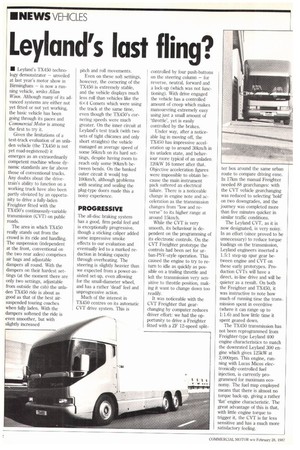Leyland's last fling?
Page 14

If you've noticed an error in this article please click here to report it so we can fix it.
• Leyland's TX450 technology demonstrator — unveiled at last year's motor show in Birmingham — is now a running vehicle, writes Allan Winn. Although many of its advanced systems are either not yet fitted or not yet working, the basic vehicle has been going through its paces and Commercial Motor is among the first to try it.
Given the limitations of a test-track evaluation of an unladen vehicle (the TX450 is not yet road-registered) it emerges as an extraordinarily competent machine whose dynamic standards are far above those of conventional trucks. Any doubts about the drivetrain's ability to function on a working truck have also been partly obviated by an opportunity to drive a fully-laden Freighter fitted with the TX450's continuously-variable transmission (CVT) on public roads.
The area in which TX450 really stands out from the crowd is its ride and handling. The suspension (independent at the front, conventional on the two rear axles) comprises air bags and adjustable dampers all round. With the dampers on their hardest settings (at the moment there are only two settings, adjustable from outside the cab) the unladen TX450 ride is about as good as that of the best airsuspended touring coaches when fully laden. With the dampers softened the ride is even smoother, but with slightly increased pitch and roll movements.
Even on these soft settings, however, the cornering of the TX450 is extremely stable, and the vehicle displays much less roll than vehicles like the 6x4 Comets which were using the track at the same time, even though the TX450's cornering speeds were much greater. On the inner circuit at Leyland's test track (with two sets of tight chicanes and only short straights) the vehicle managed an average speed of some 56kin/h on its hard settings, despite having room to reach only some 901(rn/h between bends. On the banked outer circuit it woulci top 100km/h, although problems with seating and sealing the plug-type doors made this a noisy experience.
PROGRESSIVE
The all-disc braking system has a good, firm pedal feel and is exceptionally progressive, though a sticking caliper added some impressive smoke effects to our evaluation and eventually led to a marked reduction in braking capacity through overheating. The steering is slightly heavier than we expected from a power-assisted set-up, even allowing for the small-diameter wheel, and has a rather 'dead' feel and unprogressive action.
Much of the interest in TX450 centres on its automatic CVT drive system. This is controlled by four push-buttons on the steering column — for reverse, neutral, forward and a lock-up (which was not functioning). With drive engaged the vehicle has a controlled amount of creep which makes manouevring extremely easy using just a small amount of `throttle', yet is easily controlled by the brakes.
Under way, after a noticeable lag in moving off, the TX450 has impressive acceleration up to around 30km/h in its unladen state, and behaviour more typical of an unladen 120kW 16 tonner after that. Objective acceleration figures were impossible to obtain because the main instrument pack suffered an electrical failure. There is a noticeable change in engine note and acceleration as the transmission changes from "low and reverse" to its higher range at around 15km/h.
While the CVT is very smooth, its behaviour is dependent on the programming of its electronic controls. On the CVT Freighter prototype the controls had been set for urban-PSV-style operation. This caused the engine to try to return to idle as quickly as possible on a trailing throttle and left the transmission very sensitive to throttle position, making it want to change down too readily.
It was noticeable with the CVT Freighter that gearchanging by computer reduces driver effort: we had the opportunity to drive a Freighter fitted with a ZF 12-speed split ter box around the same urban route to compare driving ease. In 17km the manual Freighter needed 88 gearchanges: with the CVT vehicle gearchanging was reduced to selecting 'hold' on two downgrades, and the journey was completed more than five minutes quicker in similar traffic conditions.
The Leyland CVT, as it is now designated, is very noisy. In an effort (since proved to be unnecessary) to reduce torque loadings on the transmission, Leyland engineers inserted a 1.5:1 step-up spur gear between engine and CVT on these early prototypes. Production CVTs will have a direct, in-line drive and will be quieter as a result. On both the Freighter and TX450, it was instructive to note how much of running time the transmission spent in overdrive (where it can range up to 1:1.6) and how little time it spent geared down.
The TX450 transmission has not been reprogrammed from Freighter-type Leyland 400 engine characteristics to match the downrated Leyland 300 engine which gives 125kW at 2,000rpm. This engine, running with Lucas Micos electronically-controlled fuel injection, is currently programmed for maximum economy. The fuel map employed means that there is almost no torque back-up, giving a rather 'flat' engine characteristic. The great advantage of this is that, with little engine torque to trigger it, the CVT is far less sensitive and has a much more satisfactory feeling.
















































































































